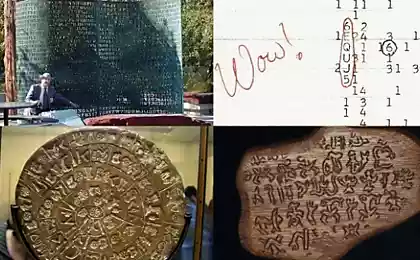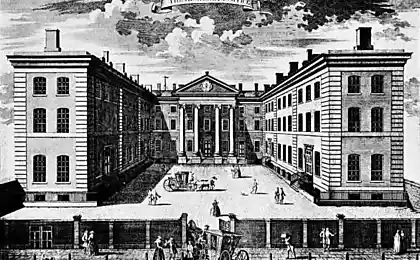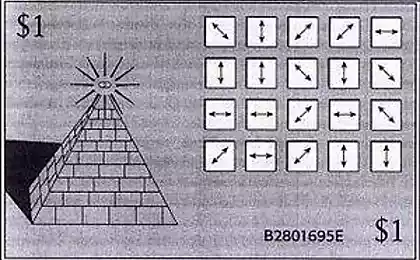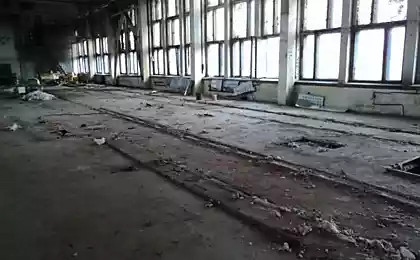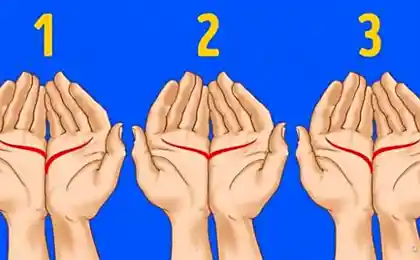1040
Eight ciphers, which did not manage to decipher (9 photos)
Steep codes and secrets.
Mystery of Tamana Shudala
In 1948, on one of the beaches of Australia's body was found a well-dressed man. In his personal belongings, among others, have found a collection of Persian poetry, on the back cover which someone had scrawled five lines of capital letters. The meaning of the message still has not managed to solve.
Taman Shudala case is a mystery of mysteries, wrapped in a mystery, the position of the secret parcels and in the secret house. He is so mysterious that the most inquisitive and meticulous detectives like Sherlock Holmes and his ilk could not untangle it.

first of December, 1948 in Adelaide, Australia, on the beach Somerton was found dead of an unknown man. He was well-developed, perfectly healthy, and very well dressed. All the labels from his clothes were cut. In his pocket was a train ticket. Unfortunately it at him and missed. It could not identify, and his dental casts do not coincide with one person. The autopsy revealed that the latter had eaten their food meat pie he ate 3-4 hours before his death, and it's actually all. Tests on foreign substances gave a negative result, but investigators were convinced that he was poisoned.
A month later, police found a brown suitcase at the railway station of Adelaide. On it was also cut off the label, as well as on the clothing of an unidentified man. Inside it was clothes, all the labels which have also been cut. Among his personal belongings in a suitcase was a brush for cleaning stencils, electric screwdriver, and a pair of scissors, commonly used for cutting stencils. Unfortunately, the investigators did not find anything substantial in the suitcase, but only established that the jacket might of American manufacturing.
For a long time the body stayed in the morgue. In June 1949, investigators re-examined the body and found a secret pocket in the clothes of the deceased, in which lay a piece of paper on which were written only two words - "Taman shud". After a thorough examination of a piece of paper revealed that he had been torn from the collection of the works of Omar Khayyam "Rubio". This discovery led to the fact that all the media have tried to find a book of which was torn piece. The search was successful. Found a man who had a rare copy of the first edition of "Rubio" translated by Edward Fitzgerald, which he said he found in the backseat of his car on the night before the body was found an unknown man. On the back cover of the book was scrawled in pencil the following:
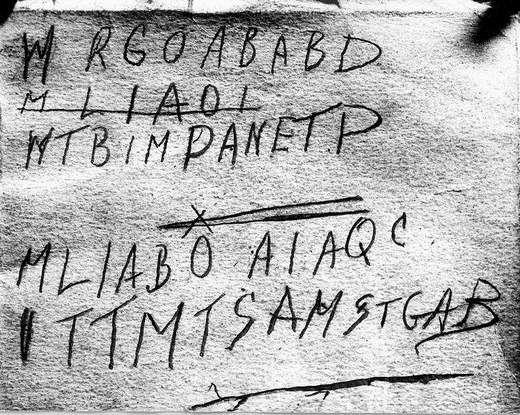
On the book was also written the phone number of the former nurse, who during the Second World gave a copy of "Rubayyata" army officer Alfred Boksellu. Boksell was still alive, and he had a copy of the undamaged "Rubayyata," and they both denied any connection with the deceased.
Some assumptions have been made in connection with another murder that occurred in the area, and it was assumed that the man was a spy working for some foreign government. This case remains unsolved today, and it looks like this will last forever.
Beale ciphers

Beale ciphers - a set of three encrypted messages that contain information about the legendary treasure, buried somewhere in Virginia. In any case, as stated in the brochure unknown author, published in 1885 by publishing house "Beech Virginian." Or is it just a hoax? Nobody knows for sure.
In one of the three ciphers specified the exact spot where the treasure of gold, silver and precious stones. In recalculation of modern money is good is worth about $ 65 million. In the other two - a detailed description of the treasure and the list of "owners", that is, the next of kin to whom the treasure should go to intestate succession. There's also determines the order of succession itself.
Passions around three cryptograms flared after the aforementioned booklet, entitled "Documents Bale or book containing the true facts about the treasure buried in 1819 and 1821. far from Bafordsa, Bedford County, Virginia, and is not found to date. " According to the author of this work, the events unfolded as follows:
In 1822, Bale gave a locked iron box with a key to the "paper of exceptional importance" to the owner of a local hotel and store it as indicating the apple of his eye. If neither the owner nor his messenger did not reappear during the next ten years, was allowed to open the box. After that Bale disappeared.
Morris decided to pick the lock only in 1843, that is waited almost twice as long as the deadline. In the box were three encryption - sheets of paper scribbled entirely rows of numbers. From now until the end of his life Morris was trying to find the key to this puzzle. To no avail.
The Ghost Writer brochure claims to have received ill-fated box along with its contents from Morris before the death of the latter, and spent the next twenty years transcript of his life.
First, he suggested that the figures - the letters of the alphabet, but then decided against it. Then it dawned on me - the cryptogram to be read on a "disposable shifrobloknota", according to which the key is a certain kind of book. He even found a book-key for a cipher - it was the United States Declaration of Independence, which has always been in the hotel room Bale. So managed to read one of the cryptograms, the one that contains the description of the treasure.
If you believe this note, in an underground mine, somewhere "far from Buford" in iron vessels buried two wagons of gold and silver. In the same message Bale talks about how the treasure came to him in 1820, he, in the company's 29-year-such as adventurers, stumbled upon a gold mine "somewhere in the 250-800 miles north of Santa Fe ».
Unfortunately, the first success was also the last - to the other two encryption keys have not been found. But since that time, as in 1885, the brochure was released by "Virginian Buk" attempts to decipher the cryptogram do not stop, and who knows, maybe luck to somebody smiles ...
Puzzle "ticking" from MIT

Specialists at the Massachusetts Institute of Technology, a giant in the field of cryptography, created a coded message on the transcript of which, by their own estimates, will require 35 years (Unless, of course, some genius will not find a solution before).
Unravel the puzzle is waiting for a prize. What's the prize - is unknown. We only know that it is stored in a tightly sealed container of lead a meter high, which, in turn, is in the archives of the Massachusetts Institute of Technical Sciences. Contents of the container will remain a mystery until until someone will read attached to it an encrypted message. The correct answer knows only one man - Ron Rivest, co-inventor of the algorithm RSA, one of the most common encryption systems emails.
Coded "clockwork", which, incidentally, also created by the algorithm RSA, first introduced to the general public in 1999, during the celebration of the 35th anniversary of the founding of the computer technology lab at MIT. If the puzzle so no one will solve the container with an "innovation time capsule" solemnly vskroyut day of the 70th anniversary of the same laboratory, ie in 2033.
Puzzle created so as to exclude any possibility to accelerate the decision by the detection of regularities or use of a distributed data processing. This task requires only "sequential thinking».
Kryptos - a monument to the CIA secrecy
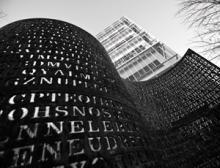
If you happen to visit the central office of the CIA in Langley (Virginia), pay attention to sculpture in the courtyard - a gigantic copper scroll, bent in the form of the Latin letter S and spotted by obscure characters. The monument is called "Kryptos". And signs - ciphertext over which twenty years unsuccessfully fighting the most experienced cryptographers. Riddle Kryptos has often been the subject of heated debate both in the CIA and beyond.
In 1988, it was decided to build the CIA headquarters new building behind the main. Ennoble the space between the two buildings commissioned American artist James Sanborn. He came up with this track with a set of 865 odd characters, and no traces of any system in the order of their arrangement. Their offspring Sanborn dubbed "Kryptos" - derived from the Greek word "hidden».
What are the only bright minds not united to solve the puzzles, all of them, including specialists of the CIA, were able to understand with only three fragments of text. They are called K1, K2 and K3. In these passages there is nothing that could shed any light on the content of the rest of the cryptogram is likely even more confusing. Here are the contents:
K1: "Between light and shadow absence of light lies the nuance of illusion»
K2: "It was totally invisible. How is this possible? They used a magnetic field of the Earth. Information was collected and transferred to underground nowhere. Does this Langley? They should: it's buried somewhere nearby. Who knows the exact location? Only WW ». (WW - a former CIA director William Webster, who Sanborn handed an envelope with full interpretation of the secret message)
K3: "With trembling hands I made a tiny slit in the top left corner. And then, widening the hole, I slipped back a candle and peered inside. Because of the hot air coming from the inside, a candle flame trembled, but then the room details emerged from the fog. You see anything? "(This is paraphrased from the diary entry archaeologist Howard Carter, who discovered the tomb of Egyptian pharaoh Tutankhamen)
Undeciphered still remain part of the last 97 characters (also known as K4). And more and more around the Kryptos rumors and controversy.
Shop around Sanborn constantly turn spies self-taught. Some even sacrifice their career for Kryptos. One such fanatic from Michigan, for example, left his thriving business in the software industry to devote himself to solving the cryptograms.
Another "ascetic", named Randy Thompson, dedicated Kriptos three years. "I think I'm close to a solution. This may happen tomorrow, and perhaps delayed until the end of my life ... »
Mysterious sculpture sparked interest and Dan Brown, author of "The Da Vinci Code," which referred to Kriptos in one of his novels.
In 1999, a computer expert from Los Angeles named James Gillogly announced that he was able to read the first three sections of encryption using a computer Pentium II and its own program.
Once the information about the success Gillogli leaked to the press, the CIA had nothing to do, how to prepare an urgent report. It turned out that a few months before Gillogli the same three sections managed to decipher CIA officer David Stein. And last cost the paper, a pencil and four hundred hours of working time. Its findings Stein reported narrow circle of colleagues in February 1998. The media, of course, this information has not got.
And Stein Gillogli and do not lose hope to deal with the remaining 97 th marks Kriptos.
"All of this has to do with secrecy - cagey Sanborn questions about his brainchild - the state of the CIA, which excites our curiosity and inflates it to cosmic dimensions. People call me the devil's agent, because I will not want to reveal this secret. But Kriptos eventually open his innermost secret ».
Voynich Manuscript
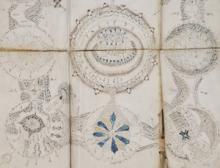
Of course, in the world abound unsolved encrypted messages. Each treasure hunter and lover of puzzles can find something to your liking. Few of them, however, cause such awe as the Voynich manuscript - a medieval book with images of medicinal plants, astrological charts, naked nymphs and text, indecipherable. One hundred years scientists struggle with decoding - and nothing else. Not having read a single word.
On the history of the manuscript is little known. In 1912, it found a bookseller Wilfrid Voynich in one of the Italian monasteries. There is a version that it once belonged to the Holy Roman Emperor Rudolf II of Bohemia.
Unread message Edward Elgar

English composer Edward Elgar was a brilliant cryptographer. One of the musical themes of his work "Enigma Variations", a name which has been called the German cipher machine, according to the author, complements the melody of the famous song of another composer. What is this song and who its composer - Elgar did not find it necessary to report.
This musical mystery - not the only extant puzzle Elgar. In 1897 he sent a coded message to the 87 signs his girlfriend Penny Dorabella. Forty years later, she published it in his memoirs, with assurances that she did not manage to decipher.
In subsequent years, many intellectuals - fans of puzzle broken off teeth on this puzzle. The document contains various symbols undulations arranged in three rows. Code analysis assumes that when you create a cryptogram, could be used in a normal "substitution cipher", in which each character corresponds to a certain letter of the alphabet.
Last mystery of the Second World

The Second World War brought to the art of cryptography contribute. This is, primarily, the transition from a manually encryption machines capable of using a constantly changing set of codes. The most famous of these devices has become an electromechanical rotary machine Enigma, which was first tested by the German Navy in 1926.
The principle of operation of Enigma amounts to replacing the characters typed text on the correspondence table. The role of encrypting unit while playing a combination of three or four rotors, each of which is represented by the 26 letters of the Latin alphabet. Installation of the rotor regularly changed, so that when sending a message the same encoding used rarely.
Thanks to Alan Turing (English mathematician, logician, and cryptographer, which has had a significant impact on the development of computer science; approx. Mixednews) and a specially designed machine called the Bombe, specialists in deciphering read many reports of Enigma, which significantly affected the course of the war. Many, however, have remained unsolved.
In 2006, an amateur expert on hacking codes Steven collapse created a project to decipher the Enigma cipher three intercepted in the North Atlantic in 1942. For this, he tried to unite thousands of the same fans around the world. The joint efforts of a few months, they have deciphered the first two posts - they were the coordinates of a German submarine and a message stating that the team came under fire and forced to dive. The third encryption has not yet succumbed.
David Kahn, author of the fundamental work on the history of cryptography "code breaker" argues that the Allies managed to decipher the codes enigmovskie only in cases where they could build their own guesses, based on the knowledge of the real situation. Only after that they used Bombes, asking the most likely setting until they came to the ciphertext. Without knowledge of the situation and the indicative content, the conviction of Kahn, the possible combinations would be so much that they did not have to check all
Who is the Zodiac?
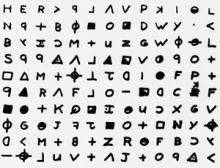
In the 60s of the last century, the elusive serial killer nicknamed the Zodiac sent a letter to the police station, which referred to himself and confessed all his crimes. The problem is that the message was encrypted, and so far no one has not been able to decipher it.
This story was holding at bay the entire San Francisco from December 1968 to October 1969. During this time at the hands of the Zodiac killed at least seven people. Local police and the newspaper regularly received letters from the killer with scathing remarks about the servants of the law, threats and coordinates more undiscovered victims. Some messages were encoded.
The murderer claimed that his identity will be revealed as soon as the encryption will be read. That did not happen, and the killer was never caught.
The first three characters of the cryptogram consisted of replacing letters. But they had one trick: some of the most common letters such as "e" stands for several characters, so to find a solution with simple decryption techniques, such as the discovery of the most common letters, it was impossible.
Three encryption were, after all, read. Helped the assumption that such a text could not do without the words "kill" and "murder".
Mystery of Tamana Shudala
In 1948, on one of the beaches of Australia's body was found a well-dressed man. In his personal belongings, among others, have found a collection of Persian poetry, on the back cover which someone had scrawled five lines of capital letters. The meaning of the message still has not managed to solve.
Taman Shudala case is a mystery of mysteries, wrapped in a mystery, the position of the secret parcels and in the secret house. He is so mysterious that the most inquisitive and meticulous detectives like Sherlock Holmes and his ilk could not untangle it.

first of December, 1948 in Adelaide, Australia, on the beach Somerton was found dead of an unknown man. He was well-developed, perfectly healthy, and very well dressed. All the labels from his clothes were cut. In his pocket was a train ticket. Unfortunately it at him and missed. It could not identify, and his dental casts do not coincide with one person. The autopsy revealed that the latter had eaten their food meat pie he ate 3-4 hours before his death, and it's actually all. Tests on foreign substances gave a negative result, but investigators were convinced that he was poisoned.
A month later, police found a brown suitcase at the railway station of Adelaide. On it was also cut off the label, as well as on the clothing of an unidentified man. Inside it was clothes, all the labels which have also been cut. Among his personal belongings in a suitcase was a brush for cleaning stencils, electric screwdriver, and a pair of scissors, commonly used for cutting stencils. Unfortunately, the investigators did not find anything substantial in the suitcase, but only established that the jacket might of American manufacturing.
For a long time the body stayed in the morgue. In June 1949, investigators re-examined the body and found a secret pocket in the clothes of the deceased, in which lay a piece of paper on which were written only two words - "Taman shud". After a thorough examination of a piece of paper revealed that he had been torn from the collection of the works of Omar Khayyam "Rubio". This discovery led to the fact that all the media have tried to find a book of which was torn piece. The search was successful. Found a man who had a rare copy of the first edition of "Rubio" translated by Edward Fitzgerald, which he said he found in the backseat of his car on the night before the body was found an unknown man. On the back cover of the book was scrawled in pencil the following:

On the book was also written the phone number of the former nurse, who during the Second World gave a copy of "Rubayyata" army officer Alfred Boksellu. Boksell was still alive, and he had a copy of the undamaged "Rubayyata," and they both denied any connection with the deceased.
Some assumptions have been made in connection with another murder that occurred in the area, and it was assumed that the man was a spy working for some foreign government. This case remains unsolved today, and it looks like this will last forever.
Beale ciphers

Beale ciphers - a set of three encrypted messages that contain information about the legendary treasure, buried somewhere in Virginia. In any case, as stated in the brochure unknown author, published in 1885 by publishing house "Beech Virginian." Or is it just a hoax? Nobody knows for sure.
In one of the three ciphers specified the exact spot where the treasure of gold, silver and precious stones. In recalculation of modern money is good is worth about $ 65 million. In the other two - a detailed description of the treasure and the list of "owners", that is, the next of kin to whom the treasure should go to intestate succession. There's also determines the order of succession itself.
Passions around three cryptograms flared after the aforementioned booklet, entitled "Documents Bale or book containing the true facts about the treasure buried in 1819 and 1821. far from Bafordsa, Bedford County, Virginia, and is not found to date. " According to the author of this work, the events unfolded as follows:
In 1822, Bale gave a locked iron box with a key to the "paper of exceptional importance" to the owner of a local hotel and store it as indicating the apple of his eye. If neither the owner nor his messenger did not reappear during the next ten years, was allowed to open the box. After that Bale disappeared.
Morris decided to pick the lock only in 1843, that is waited almost twice as long as the deadline. In the box were three encryption - sheets of paper scribbled entirely rows of numbers. From now until the end of his life Morris was trying to find the key to this puzzle. To no avail.
The Ghost Writer brochure claims to have received ill-fated box along with its contents from Morris before the death of the latter, and spent the next twenty years transcript of his life.
First, he suggested that the figures - the letters of the alphabet, but then decided against it. Then it dawned on me - the cryptogram to be read on a "disposable shifrobloknota", according to which the key is a certain kind of book. He even found a book-key for a cipher - it was the United States Declaration of Independence, which has always been in the hotel room Bale. So managed to read one of the cryptograms, the one that contains the description of the treasure.
If you believe this note, in an underground mine, somewhere "far from Buford" in iron vessels buried two wagons of gold and silver. In the same message Bale talks about how the treasure came to him in 1820, he, in the company's 29-year-such as adventurers, stumbled upon a gold mine "somewhere in the 250-800 miles north of Santa Fe ».
Unfortunately, the first success was also the last - to the other two encryption keys have not been found. But since that time, as in 1885, the brochure was released by "Virginian Buk" attempts to decipher the cryptogram do not stop, and who knows, maybe luck to somebody smiles ...
Puzzle "ticking" from MIT

Specialists at the Massachusetts Institute of Technology, a giant in the field of cryptography, created a coded message on the transcript of which, by their own estimates, will require 35 years (Unless, of course, some genius will not find a solution before).
Unravel the puzzle is waiting for a prize. What's the prize - is unknown. We only know that it is stored in a tightly sealed container of lead a meter high, which, in turn, is in the archives of the Massachusetts Institute of Technical Sciences. Contents of the container will remain a mystery until until someone will read attached to it an encrypted message. The correct answer knows only one man - Ron Rivest, co-inventor of the algorithm RSA, one of the most common encryption systems emails.
Coded "clockwork", which, incidentally, also created by the algorithm RSA, first introduced to the general public in 1999, during the celebration of the 35th anniversary of the founding of the computer technology lab at MIT. If the puzzle so no one will solve the container with an "innovation time capsule" solemnly vskroyut day of the 70th anniversary of the same laboratory, ie in 2033.
Puzzle created so as to exclude any possibility to accelerate the decision by the detection of regularities or use of a distributed data processing. This task requires only "sequential thinking».
Kryptos - a monument to the CIA secrecy

If you happen to visit the central office of the CIA in Langley (Virginia), pay attention to sculpture in the courtyard - a gigantic copper scroll, bent in the form of the Latin letter S and spotted by obscure characters. The monument is called "Kryptos". And signs - ciphertext over which twenty years unsuccessfully fighting the most experienced cryptographers. Riddle Kryptos has often been the subject of heated debate both in the CIA and beyond.
In 1988, it was decided to build the CIA headquarters new building behind the main. Ennoble the space between the two buildings commissioned American artist James Sanborn. He came up with this track with a set of 865 odd characters, and no traces of any system in the order of their arrangement. Their offspring Sanborn dubbed "Kryptos" - derived from the Greek word "hidden».
What are the only bright minds not united to solve the puzzles, all of them, including specialists of the CIA, were able to understand with only three fragments of text. They are called K1, K2 and K3. In these passages there is nothing that could shed any light on the content of the rest of the cryptogram is likely even more confusing. Here are the contents:
K1: "Between light and shadow absence of light lies the nuance of illusion»
K2: "It was totally invisible. How is this possible? They used a magnetic field of the Earth. Information was collected and transferred to underground nowhere. Does this Langley? They should: it's buried somewhere nearby. Who knows the exact location? Only WW ». (WW - a former CIA director William Webster, who Sanborn handed an envelope with full interpretation of the secret message)
K3: "With trembling hands I made a tiny slit in the top left corner. And then, widening the hole, I slipped back a candle and peered inside. Because of the hot air coming from the inside, a candle flame trembled, but then the room details emerged from the fog. You see anything? "(This is paraphrased from the diary entry archaeologist Howard Carter, who discovered the tomb of Egyptian pharaoh Tutankhamen)
Undeciphered still remain part of the last 97 characters (also known as K4). And more and more around the Kryptos rumors and controversy.
Shop around Sanborn constantly turn spies self-taught. Some even sacrifice their career for Kryptos. One such fanatic from Michigan, for example, left his thriving business in the software industry to devote himself to solving the cryptograms.
Another "ascetic", named Randy Thompson, dedicated Kriptos three years. "I think I'm close to a solution. This may happen tomorrow, and perhaps delayed until the end of my life ... »
Mysterious sculpture sparked interest and Dan Brown, author of "The Da Vinci Code," which referred to Kriptos in one of his novels.
In 1999, a computer expert from Los Angeles named James Gillogly announced that he was able to read the first three sections of encryption using a computer Pentium II and its own program.
Once the information about the success Gillogli leaked to the press, the CIA had nothing to do, how to prepare an urgent report. It turned out that a few months before Gillogli the same three sections managed to decipher CIA officer David Stein. And last cost the paper, a pencil and four hundred hours of working time. Its findings Stein reported narrow circle of colleagues in February 1998. The media, of course, this information has not got.
And Stein Gillogli and do not lose hope to deal with the remaining 97 th marks Kriptos.
"All of this has to do with secrecy - cagey Sanborn questions about his brainchild - the state of the CIA, which excites our curiosity and inflates it to cosmic dimensions. People call me the devil's agent, because I will not want to reveal this secret. But Kriptos eventually open his innermost secret ».
Voynich Manuscript

Of course, in the world abound unsolved encrypted messages. Each treasure hunter and lover of puzzles can find something to your liking. Few of them, however, cause such awe as the Voynich manuscript - a medieval book with images of medicinal plants, astrological charts, naked nymphs and text, indecipherable. One hundred years scientists struggle with decoding - and nothing else. Not having read a single word.
On the history of the manuscript is little known. In 1912, it found a bookseller Wilfrid Voynich in one of the Italian monasteries. There is a version that it once belonged to the Holy Roman Emperor Rudolf II of Bohemia.
Unread message Edward Elgar

English composer Edward Elgar was a brilliant cryptographer. One of the musical themes of his work "Enigma Variations", a name which has been called the German cipher machine, according to the author, complements the melody of the famous song of another composer. What is this song and who its composer - Elgar did not find it necessary to report.
This musical mystery - not the only extant puzzle Elgar. In 1897 he sent a coded message to the 87 signs his girlfriend Penny Dorabella. Forty years later, she published it in his memoirs, with assurances that she did not manage to decipher.
In subsequent years, many intellectuals - fans of puzzle broken off teeth on this puzzle. The document contains various symbols undulations arranged in three rows. Code analysis assumes that when you create a cryptogram, could be used in a normal "substitution cipher", in which each character corresponds to a certain letter of the alphabet.
Last mystery of the Second World

The Second World War brought to the art of cryptography contribute. This is, primarily, the transition from a manually encryption machines capable of using a constantly changing set of codes. The most famous of these devices has become an electromechanical rotary machine Enigma, which was first tested by the German Navy in 1926.
The principle of operation of Enigma amounts to replacing the characters typed text on the correspondence table. The role of encrypting unit while playing a combination of three or four rotors, each of which is represented by the 26 letters of the Latin alphabet. Installation of the rotor regularly changed, so that when sending a message the same encoding used rarely.
Thanks to Alan Turing (English mathematician, logician, and cryptographer, which has had a significant impact on the development of computer science; approx. Mixednews) and a specially designed machine called the Bombe, specialists in deciphering read many reports of Enigma, which significantly affected the course of the war. Many, however, have remained unsolved.
In 2006, an amateur expert on hacking codes Steven collapse created a project to decipher the Enigma cipher three intercepted in the North Atlantic in 1942. For this, he tried to unite thousands of the same fans around the world. The joint efforts of a few months, they have deciphered the first two posts - they were the coordinates of a German submarine and a message stating that the team came under fire and forced to dive. The third encryption has not yet succumbed.
David Kahn, author of the fundamental work on the history of cryptography "code breaker" argues that the Allies managed to decipher the codes enigmovskie only in cases where they could build their own guesses, based on the knowledge of the real situation. Only after that they used Bombes, asking the most likely setting until they came to the ciphertext. Without knowledge of the situation and the indicative content, the conviction of Kahn, the possible combinations would be so much that they did not have to check all
Who is the Zodiac?

In the 60s of the last century, the elusive serial killer nicknamed the Zodiac sent a letter to the police station, which referred to himself and confessed all his crimes. The problem is that the message was encrypted, and so far no one has not been able to decipher it.
This story was holding at bay the entire San Francisco from December 1968 to October 1969. During this time at the hands of the Zodiac killed at least seven people. Local police and the newspaper regularly received letters from the killer with scathing remarks about the servants of the law, threats and coordinates more undiscovered victims. Some messages were encoded.
The murderer claimed that his identity will be revealed as soon as the encryption will be read. That did not happen, and the killer was never caught.
The first three characters of the cryptogram consisted of replacing letters. But they had one trick: some of the most common letters such as "e" stands for several characters, so to find a solution with simple decryption techniques, such as the discovery of the most common letters, it was impossible.
Three encryption were, after all, read. Helped the assumption that such a text could not do without the words "kill" and "murder".

